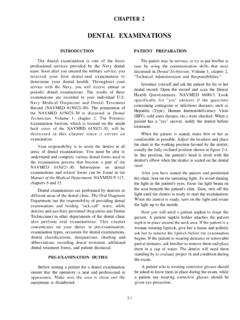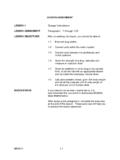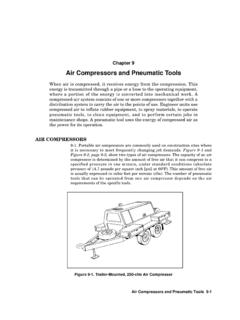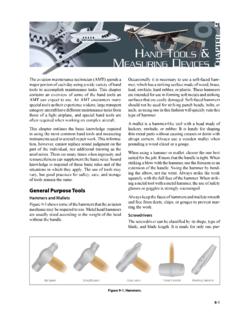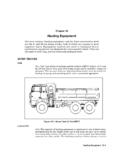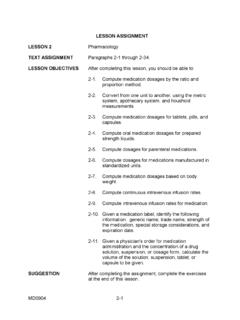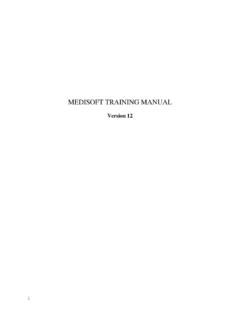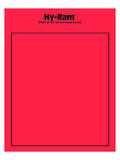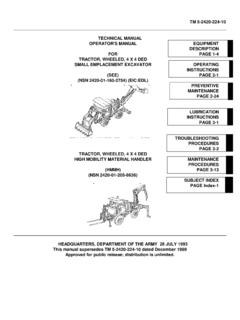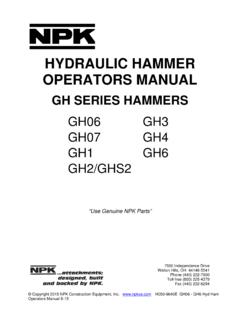Transcription of Hydraulic Excavators - sweethaven02.com
1 Chapter 8. Hydraulic Excavators Hydraulic Excavators are designed to excavate below the ground surface on which the machine rests. These machines have good mobility and are excellent for general-purpose work, such as excavating trenches and pits. Because of the Hydraulic action of their stick and bucket cylinders, they exert positive forces crowding the bucket into the material to be excavated. The major components of the Hydraulic hoe are the boom, the stick (arm), and the bucket. DESCRIPTION. 8-1. Fast-acting, variable-flow Hydraulic systems and easy-to-operate controls give Hydraulic Excavators high implement speed and breakout force to excavate a variety of materials. The Hydraulic hoe is ideal for excavating below the ground's surface on which the machine rests. A large variety of booms, sticks, buckets, and attachments give these Excavators the versatility to excavate trenches, load trucks, clean ditches, break up concrete, and install pipes.
2 The small emplacement excavator (SEE) with its hoe attachment (Figure 8-1) can work in tight places and has good mobility. Boom Stick ROPS. Loader-bucket Backhoe frame assembly controls Backhoe bucket Loader bucket Ripper shank Loader-boom cylinder Backhoe stabilizers Figure 8-1. Small Emplacement excavator Hydraulic Excavators 8-1. FM 5-434. EXCAVATION TECHNIQUES. 8-2. The hoe is normally associated with two types of excavations trenching (linear-type) and basement (area-type). The operator should judge the length and depth of cut to produce a full bucket with every pass (Figure 8-2). Dumping height Digging reach Maximum depth for level bottom Maximum digging depth Figure 8-2. Hoe-Bucket Operating Dimensions TRENCHES. 8-3. Figure 8-3 shows parallel and perpendicular trenching using a SEE hoe attachment.
3 Parallel Perpendicular Figure 8-3. A SEE Digging Trenches With a Hoe Attachment 8-2 Hydraulic Excavators FM 5-434. Parallel 8-4. With the parallel method, center the hoe on the trench, while keeping the tractor in line with the trench center line. As the digging progresses, move the machine away from the excavation and load the material into haul units or stockpile it along the side of the trench for later use as backfill. Perpendicular 8-5. When using the perpendicular method, dig the trenches in two or more cuts or lifts. To excavate the top 35 to 45 percent of the trench depth, make the first cut with the boom carried high. To finish the cut and remove the remainder of the material, move forward about one-half the length of the machine with the boom carried low. Although this method involves more and shorter moves, it has better bucket digging angles and shorter hoisting distance on the top lifts.
4 BASEMENTS. 8-6. Many variations of the two basement-excavation sequences shown in Figure 8-4 are possible. The procedures vary with the design and shape of the excavation, the restrictions of surrounding properties, and the requirements for disposing of the spoil. The first cut is a trench with vertical outside walls. To minimize handwork or cleanup, dig all outside wall faces vertically. Plan the starting point and the digging sequence so that the machine conveniently works itself out of the excavation. Dig trenches for service pipes last; dig them from the basement outward. Straddle the machine over the outer edge and dig over the end and side of the tractor. Move the machine as the arrows in the figure indicate. Figure 8-4. Two Methods of Excavating Basements OPERATION TECHNIQUES. UNDERGROUND UTILITIES.
5 8-7. Survey the area for underground hazards as well as for surface obstacles before digging. This applies particularly to populated areas with multiple underground utilities. Hydraulic Excavators 8-3. FM 5-434. CONFINED QUARTERS. 8-8. Working in confined quarters is not efficient from a production standpoint. If expecting considerable close-quarter work, plan to use small machines that can operate efficiently with a minimum work radius. DRAINAGE DITCHES. 8-9. If the job is to continue during wet seasons or in wet areas, give prime consideration to drainage. Begin ditch excavations at the lower end and work toward the upgrade. HARD MATERIALS. 8-10. A hoe will dig into fairly hard materials. However, blasting or ripping may be more efficient than breaking through hardpan and rock strata with the bucket.
6 Once the trench is open, break the ledge rock by pulling the bucket up under the layers. Remove the top layers first, lifting only one or two layers at a time. SMALL EMPLACEMENT excavator WITH A LOADER BUCKET. 8-11. The SEE is a lightweight, all-wheel-drive, diesel-engine, high-mobility machine. It is equipped with a hoe, a loader bucket, and other Hydraulic attachments, which normally include a hammer drill, a chainsaw, and a pavement breaker. Check the operator's manual for using the S EE's Hydraulic -mounted attachments. The SEE weighs less than 16,000 pounds, is air-transportable, can travel more than 50 mph on improved roads, and has excellent off-road mobility. EXCAVATING. 8-12. Under average conditions, small hoes bucket size less than 1 cubic yard can complete an excavation cycle in 14 seconds.
7 An excavation cycle consists of loading the bucket, swinging the loaded bucket, dumping the bucket, and swinging the empty bucket. Average conditions would be a depth of cut between 40 and 60 percent of the machines rated maximum digging depth and a swing angle of between 30 to 60 . The average cycle time for bucket sizes from 1 cubic yard to less than cubic yards is 15 seconds. Greater digging depths or swing angles increase the cycle time. 8-13. Make sure the hoe is level before operating. Lower the front loader bucket to the ground (flat) so that the machine's front wheels are not in contact with the surface. Move the gearshift and the range-shift levers to their neutral positions, and lower the outriggers. Use the outriggers to level the machine and to raise the rear wheels slightly above the ground.
8 Always operate with the least amount of bucket-arm swing. 8-14. For evaluating heaped capacity, hoe buckets are rated with an assumed material repose angle of 1:1. Therefore, actual bucket capacity depends on the type of material being excavated as all materials have their own natural repose angle. Table 8-1 provides bucket fill factors for hoe buckets based on material type. 8-4 Hydraulic Excavators FM 5-434. Table 8-1. Bucket Fill Factors for Hoe Buckets Material Fill Factor (Percent). Moist loam or sandy clay 100 to 110. Sand and gravel 95 to 110. Rock (poorly blasted) 40 to 50. Rock (well blasted) 60 to 75. Hard, tough clay 80 to 90. 8-15. Bucket Cylinder. When using the bucket cylinder to excavate, follow these steps (Figure 8-5): Step 1. Put pressure on the boom to force the bucket teeth or cutting edge into the ground.
9 Step 2. Roll the bucket toward the machine until it is full. Step 3. Raise the bucket, in a smooth operation, high enough above the trench to clear the spoil pile or the hauling unit, and dump the excavated material. Figure 8-5. Bucket-Cylinder Operation 8-16. Stick Cylinder. The maximum digging force is developed by operating the stick cylinder perpendicular to the stick. As a rule, the optimum depth of cut for a hoe is 30 to 60 percent of the machine's maximum digging depth (Figure 8-2, page 8-2). When using the stick cylinder to excavate, follow these steps: Step 1. Lower the bucket into the digging position (Figure 8-6 [A]). Step 2. Roll the bucket until the bucket teeth or the cutting edge is flat on the ground (Figure 8-6 [B]). Hydraulic Excavators 8-5. FM 5-434. Step 3. Use the stick cylinder to move the bucket toward the machine until it is half full (Figure 8-6 [C]).
10 Step 4. Raise the stick and roll the bucket until it is full (Figure 8-6 [D]). Figure 8-6. Hoe Digging Technique Loader Bucket 8-17. When digging with a loader bucket . Use the bucket cylinders to help break the ground loose instead of depending on the forward movement of the machine, as in the loader crowding technique. Do not raise the bucket higher than necessary to dump the material. Use as flat a ramp as possible when starting an excavation. Plan the job so that most of the hauling from the excavation can be done when driving the unit forward. A steeper ramp can be used when driving forward than when driving in reverse. Keep the working area level. LOADING. 8-18. To excavate and load, a hoe bucket must raise through the digging motion and above the haul unit. If possible, spot the truck on the pit floor.
